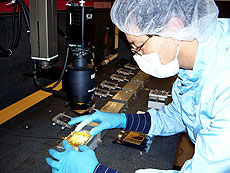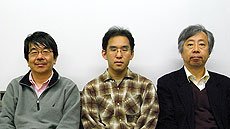Have a safe day!
Thursday, Jan. 21
2:30 p.m.
Theoretical Physics Seminar - Curia II
Speaker: Gerben Stavenga, Fermilab
Title: Vortices in the Jackiw-Pi Model on the Torus
3:30 p.m.
DIRECTOR'S COFFEE BREAK - 2nd Flr X-Over
THERE WILL BE NO ACCELERATOR PHYSICS AND TECHNOLOGY SEMINAR THIS WEEK
Friday, Jan. 22
3:30 p.m.
DIRECTOR'S COFFEE BREAK - 2nd Flr X-Over
4 p.m.
Joint Experimental-Theoretical Physics Seminar - One West
Speaker: David Weinberg, Ohio State University
Title: The Sloan Digital Sky Survey, and Its Children
8 p.m.
Fermilab Lecture Series - Ramsey Auditorium
Title: Evolution in the 21st Century
Tickets: $7
Speaker: Dr. James Shapiro, University of Chicago
Click here for NALCAL,
a weekly calendar with links to additional information.
Upcoming conferences |
|
For information about H1N1, visit Fermilab's flu information site.
|
|
Thursday, Jan. 21
- Breakfast: Apple sticks
- Tomato Florentine
- BBQ pork sandwich
- Kielbasa & sauerkraut
- Chicken Marsala
- Smoked turkey melt
- Assorted sliced pizza
- SW chicken salad w/roasted corn salsa
Wilson Hall Cafe Menu |
|
Thursday, Jan. 21
Dinner
- Pasta carbonara
- Stuffed filet of sole w/ crabmeat
- Sautéed spinach w/ lemon & pine nuts
- Salad of field greens, pear & shaved parmesan
- Pecan rum cake
Wednesday, Jan. 27
Lunch
- Chicken & vegetable stir fry w/cashew rice
- Orange almond cake
Chez Leon Menu
Call x3524 to make your reservation.
|
|
|
Dial-a-technician: Fermilab lends BNL design expertise
 |
Fermilab technician Bert Gonzalez handles silicon detector components at SiDet. |
For the first time, Fermilab technicians have completed design work for a 4,000-ton particle detector over the phone.
"The benefit of our past experience allowed us to design through conference calls," said Bert Gonzales, Fermilab technical supervisor on the design project. "This is a new endeavor. We've never assembled a project in this fashion. Usually we've had everything in-house."
Scientists in the PHENIX collaboration at Brookhaven National Laboratory have enlisted the expertise of a group of technicians at Fermilab's SiDet facility to upgrade their particle detector, originally constructed in 2000.
Technicians at SiDet, which is short for silicon detector, have in the past built components that track particles in the hearts of the CDF and DZero detectors at Fermilab's Tevatron. The technicians also contributed a large number of components for the CMS silicon detector at CERN's Large Hadron Collider.
Originally Brookhaven planned to build new parts at academic institutions, said Dave Winter, Columbia University physicist. He coordinates between Brookhaven and Fermilab in a portion of the design and production effort. But Brookhaven was impressed by the extensive related experience technicians had at SiDet.
"Once we saw what was already at Fermilab, it was a no-brainer," Winter said. "We'd be crazy to do it ourselves."
The Pioneering High Energy Nuclear Interaction Experiment, or PHENIX, detector combs through the subatomic chaos produced by collisions at the Relativistic Heavy Ion Collider, or RHIC. Scientists at RHIC crash protons, gold nuclei and the nuclei of a hydrogen isotope called deuterium together in an effort to recreate the conditions of the early universe.
Brookhaven scientists have collected evidence that RHIC has created quark-gluon plasma, a state of matter in which quarks float unbound from one another. Scientists theorize that quarks behaved this way in the split second after the Big Bang.
Read more
-- Kathryn Grim
|
URA accepting submissions for annual Thesis Award
Fermilab and the Universities Research Association invite submissions for the 13th annual URA Thesis Award competition. The award recognizes the most outstanding thesis related to work conducted at Fermilab or in collaboration with Fermilab scientists. The thesis submitted must be completed in the 2009 calendar year to qualify.
Nominations must be submitted to sbrice@fnal.gov by March 1, and should include at least two letters supporting the merits of the thesis. At least one letter should be from a member of the thesis committee of the Ph.D.-granting institution.
The thesis awards committee will select the winners. The committee members will judge each thesis on clarity of presentation, originality and physics content. To qualify, the thesis must have been submitted as partial fulfillment of the Ph.D. requirements in the 2009 calendar year, be written in English and it must have been submitted in electronic form to the Fermilab Publications Office in accordance with Fermilab policy.
For further details, consult the URA Thesis Award Web site.
|
Lecture on evolution in the 21st century -- Friday at 8 p.m.
Darwin spent a lot of time looking at finches. James Shapiro of the University of Chicago spends his time looking at bacteria. Although his subjects may not be as cuddly as Darwin's, Shapiro can still study their DNA. Genome sequencing and other technological advances are giving bacterial geneticists like Shapiro the ability to actually see inside the genetic workings of an organism--to essentially observe evolution in action.
That is leading to new discoveries about how evolution really works. For almost two decades now, Shapiro has been developing his own theories about what he calls "natural genetic engineering." To an unpracticed ear, it sounds a bit like nature is busy developing its own super-species, without any help from us. Find out more at the lecture on Friday.
Tickets are $7. For further information or telephone reservations, call 630/840-ARTS (2787) Monday, Wednesday and Friday between 10 a.m. and 3 p.m. More information
|
Business profile: Extrutech Plastics, Inc.
From Manitowoc Herald Times Reporter, Jan. 17, 2010
Manitowoc plastics manufacturer lands federal contract to aid physics research
Name of business: Extrutech Plastics, Inc.
Ownership: Chief Executive Officer Hilmar O. Skagfield owns Extrutech Plastics in Manitowoc and Skandia Window Fashions based in Tallahassee, Fla., with additional plants in San Diego and Thomasville, Ga.
Origins of business: Greg and Debbie Sheehy founded Extrutech Plastics in 1992.
"We began with one used extrusion line in a rented building in Manitowoc," President Greg Sheehy said. "The business was acquired by the Skandia corporation in 2004 as a subsidiary."
Read more
|
|
|
Breaking the balance
 |
Forward-backward asymmetry fits results as a function of q2 for B0→K*0µµ, where q2 is square of the di-muon mass. Solid (dotted) curve is the Standard Model (an example of supersymmetry) expectation, dashed line is the averaged expectation in each q2 bin, and green hatched regions are excluded from the analysis due to large resonant backgrounds at these mass values. |
Although most measured physics processes and particle properties agree well with Standard Model predictions, in some cases, rare new physics processes could make things a bit lopsided. Picture a seesaw where one side represents the prediction of the Standard Model and the other side represents what we observe in data. When we select a large number of events, the seesaw might still look mostly balanced even if there are a few events from some new physics process not included in the Standard Model. However, it might be possible to study very rare Standard Model processes where just a few events from something more exotic would break the balance in a very significant way, giving scientists a better chance of finding new physics.
Hoping to find the seesaw off balance, CDF scientists have looked at such a rare decay: the neutral Bd meson into the neutral K* meson and two muons. This decay occurs in only one out of a million Bd meson decays. Even so, scientists have found about 100 signal events of this decay mode in 4.4 inverse femtobarns of CDF data. The scientists also studied a specific feature of the decay: the muon forward-backward asymmetry, a process particularly sensitive to new physics. In the Standard Model, the asymmetry is expected to have a negative value in the lower region of the di-muon system mass and a positive value in the higher region, as shown by the red line in the figure. This asymmetry could show a drastically different behavior than the one predicted by the Standard Model under some new physics scenarios such as supersymmetry. This is the first measurement of this quantity at a hadron collider, and the result is consistent and competitive with measurements from electron/positron colliders.
Using a similar analysis procedure, the CDF scientists also observed the most rare Bs meson decay ever: the decay into the Phi meson and two muons. They found 27±6 Bs signal candidates and made the first measurement ever of this decay rate. Scientists will continue to study this new channel, and who knows, maybe even obtain some hints that new physics is breaking the balance of the Standard Model.
 |
| From left: Fumihiko Ukegawa, Hideki Miyake and Shinhong Kim, all with University of Tsukuba, Japan. |
|
|